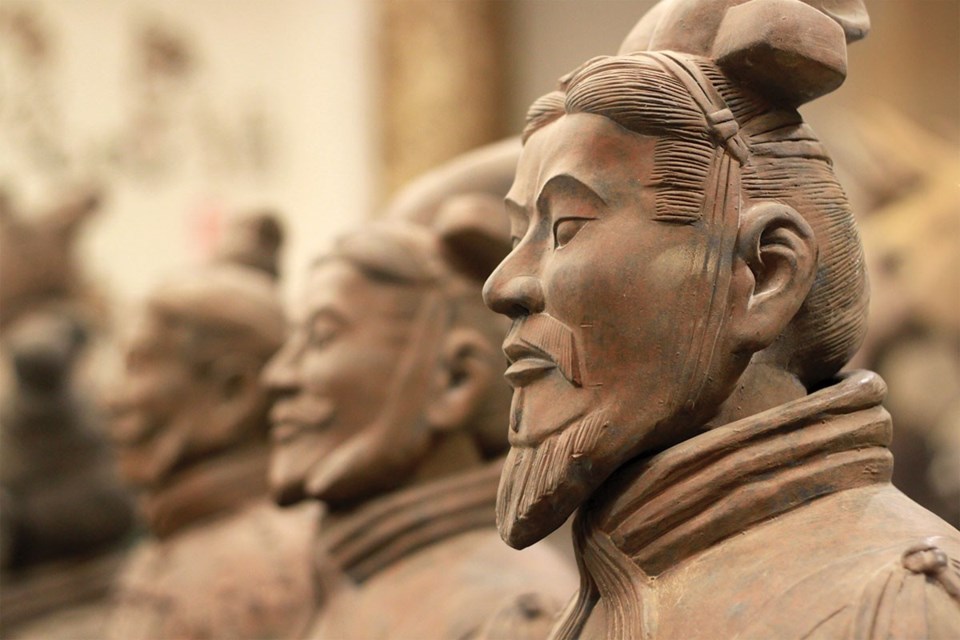It's a story about the founding of China's first dynasty in 221 B.C.E. and a young emperor's obsession with immortality. Though Qin Shi Huang (also spelled Qin Shihuang) ascended the throne at the age of 13, his youth didn't preclude him from an obsessive lifetime compulsion to protect himself in the hereafter.
And so it was that the first-minted emperor immediately began construction on an underground palace for his afterlife, defended by an army of about 8,000 life-size terra cotta warriors, 670 horses, 130 chariots and about 40,000 bronze weapons consisting of swords, longbows, arrowheads, spears, and dagger-axes. The weapons were treated with advanced metallurgy techniques of the day to prevent rust and corrosion, rendering them sharp, even after a prolonged double millennial burial.
It has been estimated that the project involved over 700,000 workers, many whom unwittingly lost their lives to protect the secrets of where the emperor buried his precious jewels and wealth. Still, it is remarkable to note that this is the first indication of royalty using funerary art as a means of protection in the next life. Prior to this, it was customary to bury soldiers and attendants with the deceased.
The legion of clay soldiers and horses was interred for over 2,000 years when quite by accident a group of farmers came upon broken pottery fragments while digging a well. The year was 1974 and the place was in the Shaanxi province of northwest China, northeast of modern-day Xi'an. The clay shards were but a harbinger of one of the greatest archaeological discoveries of modern times. Some even call the discovery of the terracotta soldiers the "8th Wonder of the World." The importance of the find was captured in 1987 when the site was designated a UNESCO World Heritage Site.
Today, one can view three pits that have been partially excavated, though a fourth pit was surprisingly found empty. (It is thought that the vacuous hole was destined for more clay soldiers, perhaps unrealized by the unexpected death of Qin at 50 years of age.) More than 400 additional pits are nearby and remain unexcavated due to concerns about preservation of the terra cotta figures and confirmed high levels of mercury. This adds substance to the legend about the emperor surrounding his mausoleum with rivers of mercury.
The three pits contain terracotta soldiers that generally fall in three major categories: infantry, charioteers, and cavalry. The infantry is the more numerous and includes kneeling and standing archers, foot soldiers both lightly and heavily armed, and officers of varying ranks. Charioteers encompass both drivers and warriors.
Cavalry warriors and horses include some saddled horses, though interestingly there are no stirrups. They hadn't been invented at the time of the emperor, rather the stirrup was invented in China a couple hundred years AD. Paired stirrups is generally credited to the Chinese Jin Dynasty, but not until the Middle Ages did the innovation spread to Europe. Now, back to the saddles. The discovery of the terra cotta saddled equine dating back to 210 B.C.E. (the year Emperor Qin died and was buried) completely blows a hole in the general assumption that Sarmatians invented the saddle in 365 AD.
As if the size of the mausoleum isn't staggering enough, covering nearly 14,000 acres and bigger than the Vatican City, an amazing fact about the unearthed terracotta army is that every figure differs in its facial features and expression, clothing, and hairstyle. Details extend from hairlines and hats to the soles of the feet. The key was that about eight facial moulds were used to cast the army and details were applied afterwards to make each unique.
Considered a bucket list for many, the Museum of Qin Terra-cotta Warriors and Horses is about an hour north of Xi'an, the oldest of China's four great ancient capitals and considered a birthplace of Chinese civilization. It is also the capital of Shaanxi Provence.
Check out Xiamen Airlines for relatively inexpensive flights to the city of the same name—Xiamen. From Xiamen, it's less than a three-hour flight to Xi'an. Look for promos as I got lucky and was able to snag a round-trip deal for US$425 from Los Angeles to Xiamen in March 2018.




